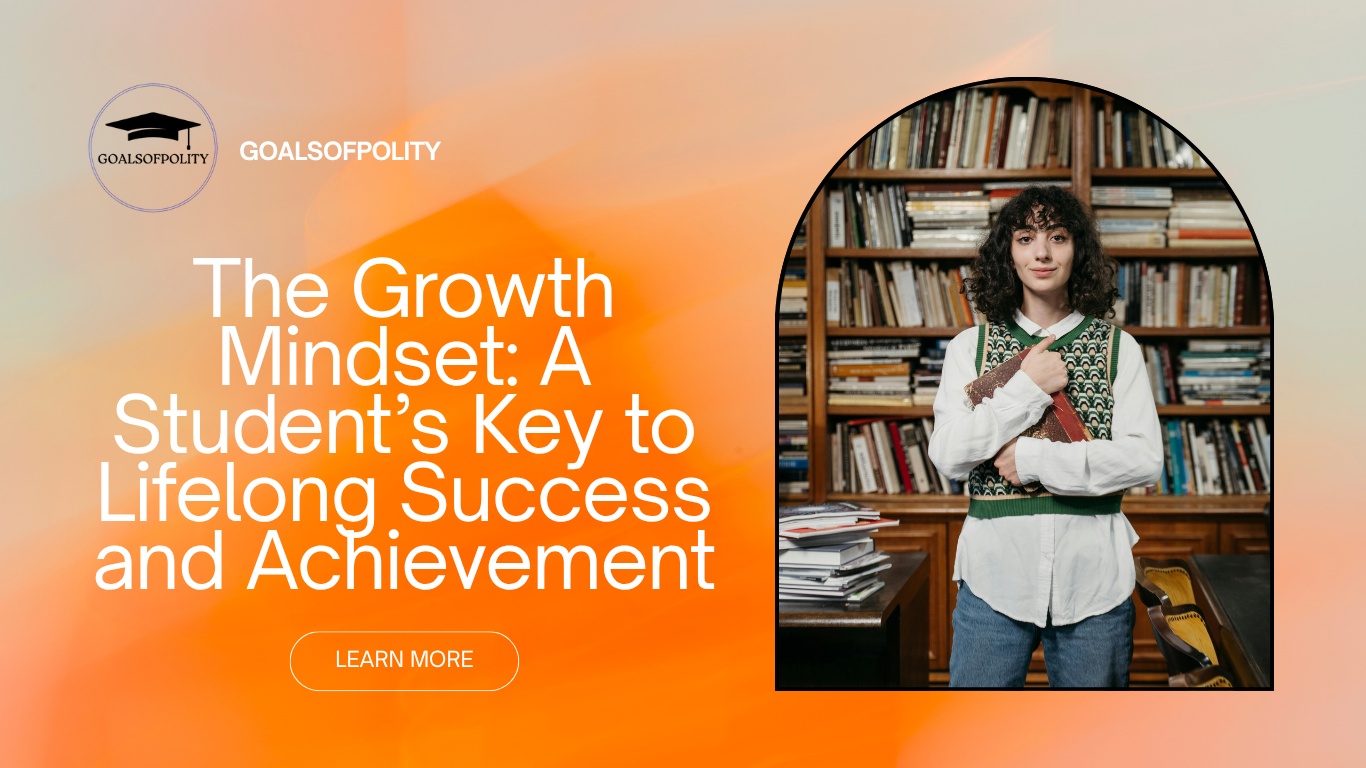Table of Contents
Introduction: Success Begins in the Mind
Every successful journey begins with a simple belief – that growth is possible. For students, this confidence forms the foundation of learning and achievement. How you think about intelligence and effort determines how far you can go.
That’s why developing a growth mindset is so powerful. It teaches that talent isn’t fixed and that abilities can be improved through hard work, learning, and perseverance. This mindset doesn’t just help students perform better in school – it builds lifelong confidence, curiosity, and resilience that extends to every career and personal goal.
1. What is a Growth Mindset?
The term “growth mindset” was coined by psychologist Dr. Carol S. Dweck. It refers to the belief that our basic qualities – such as intelligence and talent – can be developed through dedication and hard work.
In contrast, a fixed mindset assumes that intelligence and abilities are inherent traits that cannot be changed.
| Fixed Mindset | Growth Mindset |
| “I can’t do this.” | “I can’t do this yet.” |
| Avoids challenges | Embraces challenges |
| Fears failure | Learns from failure |
| Seeks validation | Seeks improvement |
The simple idea of adding “yet” transforms how students approach challenges — turning discouragement into determination.
2. Why Mindset Matters More Than Talent
Talent may provide a starting point, but mindset determines your journey. Students who believe they can improve are more likely to persevere through difficulties and achieve better results.
Growth-minded students:
- View failure as feedback.
- Adapt and find new strategies.
- See effort as the path to mastery.
- Believe in continuous learning.
In both the classroom and career, success goes not to the most talented, but to the most diligent.
3. The Psychology Behind a Growth Mindset
Modern neuroscience proves that the brain has the capacity for neuroplasticity – meaning it can grow and rewire itself throughout life.
Every time you learn something new, your brain forms stronger connections. This means that effort literally strengthens your intelligence.
Dr. Dweck’s research showed that when students were praised for their effort rather than their intelligence, they became more motivated, more resilient, and more prepared to face challenges.
Tip: Praise the process rather than labeling ability (“You worked so hard on that project!”) instead of (“You’re so smart!”).
4. Key Characteristics of Growth-Minded Students
Students who develop a growth mindset share several common characteristics:
- Curiosity: A desire to learn, explore, and ask questions.
- Resilience: The ability to bounce back quickly from setbacks.
- Perseverance: Continuing to try even when things are difficult.
- Openness to feedback: Accepting criticism as a tool for improvement.
- Positive thinking: Focusing on solutions, not problems.
- Self-reflection: Analyzing what worked and what didn’t.
These characteristics make them lifelong learners who succeed both academically and professionally.
5. Academic Benefits of a Growth Mindset
A growth mindset transforms how students approach their studies:
a. Improved Learning Habits
They focus on understanding rather than rote memorization.
b. Reduced Fear of Failure
Challenges become opportunities to adjust strategies.
c. Increased Motivation
Belief in improvement fuels consistent effort.
d. Collaborative Spirit
They enjoy learning from peers and mentors.
e. Long-Term Performance
Their continuous improvement leads to sustained academic success.
6. Growth Mindset and Career Success
Career success today depends on adaptability, creativity, and continuous learning. A growth mindset equips students with these qualities:
- Adapting to Change: Staying updated as industries evolve.
- Continuous Learning: Acquiring new skills and certifications.
- Handling Rejection: Viewing failure as a stepping stone.
- Effective Leadership: Inspiring others with positivity and perseverance.
Employers value these qualities even more than raw talent – because mindset drives lifelong growth.

7. How to Break Free from a Fixed Mindset
Shifting from a fixed to a growth mindset requires awareness and practice:
- Identify limiting beliefs – Replace “I can’t” with “I can learn.”
- Embrace discomfort – Growth happens outside your comfort zone.
- Seek constructive feedback – Learn from mentors and teachers.
- Celebrate progress – Reward improvement, not perfection.
- Surround yourself with learners – Environment shapes mindset.
- Reflect daily – Identify one thing you learned from each experience.
Remember, every effort counts – your mindset is strengthened through repetition.
8. Step-by-Step Plan to Build a Growth Mindset
| Step | Action | Result |
| Step 1 | Identify fixed thoughts | Awareness of your current mindset |
| Step 2 | Reframe negative language | Builds optimism |
| Step 3 | Take small learning risks | Reduces fear of failure |
| Step 4 | Set process goals | Keeps focus on daily improvement |
| Step 5 | Reflect weekly | Encourages accountability |
| Step 6 | Learn from others’ stories | Inspires persistence |
| Step 7 | Keep challenging yourself | Continuous personal evolution |
Growth doesn’t happen overnight — it’s built through consistent, intentional actions.
9. Growth Mindset and Emotional Health
Students with a growth mindset experience better emotional stability and mental well-being because they:
- Feel less anxious about performance.
- Learn to accept themselves through progress.
- Handle failure with maturity.
- Become optimistic about the future.
When you believe you can improve, obstacles lose their power to define you.
10. Inspiring Real-Life Examples
Thomas Edison: Failed thousands of times before inventing the light bulb – each failure was a lesson.
J.K. Rowling: Faced numerous rejections before Harry Potter became a global success.
Michael Jordan: Was cut from his school basketball team – he used that failure to fuel his training.
Their stories show that success doesn’t mean never failing; it means never giving up.
11. How Parents and Teachers Can Foster a Growth Mindset
- Use effort-based praise instead of talent-based praise (“You worked hard”).
- Create a safe learning environment for trial and error.
- Encourage goal setting and self-assessment.
- Share stories of perseverance and real-world growth.
- Model your own learning process – show students that adults make mistakes too.
When teachers and parents practice growth thinking, students naturally follow suit.
12. Challenges in Maintaining a Growth Mindset
Despite awareness, students may face challenges such as:
- Comparison with peers
- Academic competition
- Lack of motivation
- Negative environment
Solution: Stay persistent. Remind yourself why you started and focus on progress over perfection.
13. The Lifelong Impact of a Growth Mindset
A growth mindset doesn’t end in school – it becomes a lifelong advantage. It helps you:
- Adapt to changing industries.
- Embrace lifelong learning and upskilling.
- Handle rejection with grace.
- Stay humble even when you’re at the top.
- Find joy in the process of improvement.
Success is temporary; growth is permanent.
Conclusion: The Mindset That Shapes Your Future
A growth mindset is more than just an academic concept – it’s a way of life. It transforms obstacles into opportunities and effort into excellence.
Students who believe in growth don’t just chase grades; they cultivate confidence, adaptability, and a love for learning that lasts a lifetime. No matter where you start, remember that you have unlimited potential; you just need to hone your abilities. Success doesn’t begin with what you know, but with how you think.
Frequently Asked Questions (FAQs)
Q1. What is a growth mindset for students?
A growth mindset is the belief that students can improve their intelligence, skills, and performance through effort, learning, and perseverance. It helps them face challenges, overcome failures, and achieve long-term success in both academics and life.
Q2. How can students develop a growth mindset?
By embracing challenges, learning from mistakes, and focusing on effort rather than talent.
Q3. How does mindset affect career success?
It fosters adaptability, flexibility, and a continuous learning mindset – all crucial for professional growth.
Q4. Can students change a fixed mindset?
Yes. By consciously changing negative thoughts and appreciating effort, students can adopt a growth mindset.
Q5. Why is a growth mindset important in education?
It helps students stay motivated, overcome failures, and develop lifelong learning habits.
Q6. What role do parents and teachers play?
They can foster growth thinking by providing positive feedback, patience, and encouraging curiosity.
Q7. Does a growth mindset improve mental health?
Yes. It reduces anxiety and promotes positivity by focusing on progress rather than perfection.
Q8. Is intelligence fixed or flexible?
Modern neuroscience shows that intelligence can be increased through learning and brain plasticity.
Q9. What are some daily habits for a growth mindset?
Think critically every day, learn a new skill, and regularly challenge your comfort zone.
Q10. Can students who adopt a growth mentality be successful in life?
Absolutely – it builds the emotional, mental, and intellectual strength necessary for lifelong success.

